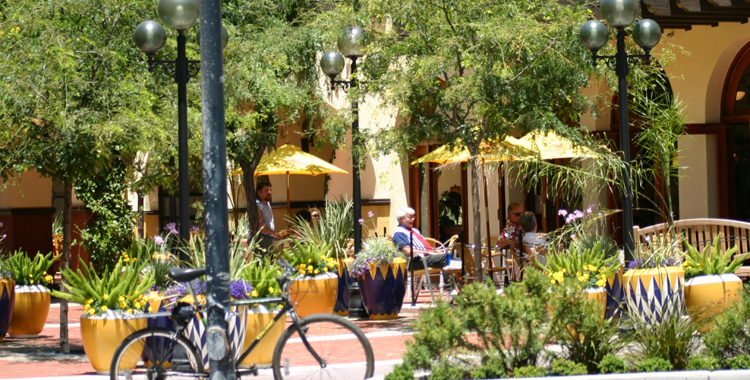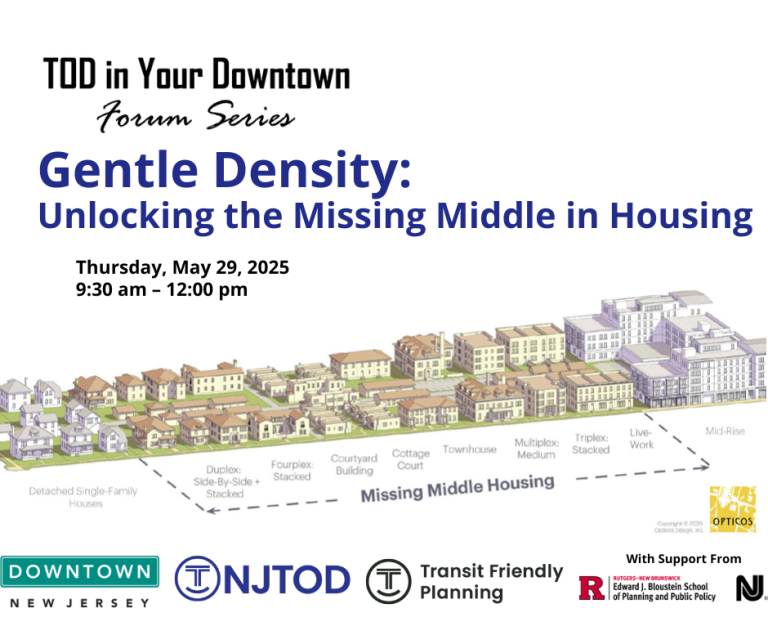Downtown New Jersey has selected the following story as a guest post in an effort to share a variety of information with our members.
As has been widely documented, America’s urban and downtown areas began a long period of decline in the ’50s and ’60s. The popularity of the automobile changed individual and commercial behavior, and the focus of commercial activity shifted from the cities to the suburbs. During the late ’60s and ’70s, cities declined further as white flight to the suburbs accelerated. The result was a vicious cycle in which downtown businesses closed because of population declines, which increased the rate at which residents and visitors left downtown areas (Robertson 1999*).
Why is downtown revitalization needed?
In spite of these trends, research shows that a healthy and vibrant downtown boosts the economic health and quality of life in a community. Specifically, it creates jobs, incubates small businesses, reduces sprawl, protects property values, and increases the community’s options for goods and services. A healthy downtown is a symbol of community pride and history.
There are signs of life in urban areas. The nineties saw the beginning of downtown revitalization from population increases in urban and downtown areas, particularly among young middle- and upper-class individuals and families, as well as decreases in crime rates. Commercial investment in small cities is also growing, albeit slowly (Local Initiatives Support Corporation [LISC]*). Much of this downtown revitalization is created by Community Development Corporations (CDCs). CDCs are nonprofit organizations that rely on private and government funding, and use community-based strategies to revitalize downtown areas. These organizations were established about thirty years ago, and today there are more than 2,500 of them. Left unanswered, however, is the question of which downtown revitalization strategies are more or less successful.
Evidence in this area is difficult to find. Most studies generalize their findings based on a single downtown or a handful of cities. The most rigorous evidence comes from a small number of projects, based on a sample of more than twenty cities that differ in region, economic status, and other demographics. From these studies, a few strategies stand out as particularly successful.
Downtown Revitalization Program Strategies
- Aim for a multi-functional downtown.
Successful downtowns attract a wide range of individuals by affecting housing, work, shopping, culture, entertainment, government, and tourist attractions (Robertson 1995*). - Develop a broad strategy for revitalizing downtown areas.
Blueprints for improving downtown areas must address several areas at once. A 1999 census of programs by the Local Initiatives Support Corporation, which has partially funded community development programs for twenty-one years, finds that “supporting community development in the next ten years needs to mean supporting the whole community development agenda—the human, social, and economic dimensions as well as the physical” (LISC, 3*). Downtown revitalization should include not only new housing and commercial businesses, but also after-school programs, anti-crime initiatives, youth development and employment services, arts, recreational opportunities, and public transit. - Create partnerships.
Downtown revitalization encompasses a wide range of activities. Therefore, it requires the cooperation of local government, chambers of commerce, the private sectors, civic organizations, and other key institutions. - Pay particular attention to attracting commercial business.
Businesses are often more comfortable and familiar working in suburban areas than downtown. In particular, downtowns should provide guidance with financing, parking areas, zoning, and building design (Robertson 1999*). - Focus on developing the unique qualities of downtowns.
Downtowns have an advantage over suburban developments in terms of their historical value and compact, walking-friendly size. Development should focus on these strengths by preserving historical architecture and promoting traditional architecture through zoning and adaptive reuse of existing structures. Downtowns should also improve pedestrian walkways through installation of attractive lights, benches, and flowers in order to draw shoppers and other traffic. Cities with waterfronts have found that developing these sites for tourists and residents is particularly successful (Robertson 1999*). - Maintain and develop genuine public spaces.
The legacies of urban renewal programs are downtowns with fewer sidewalks, more car traffic, and more “dead spaces” such as parking lots, highway ramps, and vacant buildings. As a result, pedestrian activity and public gathering in many cities is discouraged. Careful planning through widening sidewalks, encouraging mass transit, and landscaping can encourage “on-street” activities such as commerce and dining and widen the public sphere, promoting community (Robertson 1995*). - Make strategies locally based and flexible.
Downtown revitalization programs must be flexible not only in terms of goals, but must also adapt their strategies to local needs. Market research aids in helping communities determine which projects match local demand. It is also crucial to take advantage of the particular skills of residents and local program coordinators (LISC*). - Secure multiple sources of funding.
Although it is important to secure funding from a variety of sources, assistance from local governments is particularly important for long-term project sustainability (The Urban Institute*). - Get local governments involved in several areas.
The National Main Street Center of the National Trust for Historic Preservation conducts an annual survey of organizations in communities that are revitalizing their downtown and commercial districts. In 2000, four of the five factors most helpful to development cited in the survey-securing favorable zoning codes, retaining government offices, increasing housing stock, and approving historic preservation codes-all require local government involvement. Governments can use their regulatory powers to make it easier for a wide variety of small businesses to locate downtown, as well as help preserve existing housing and promote new, affordable housing (National Main Street Center*).



